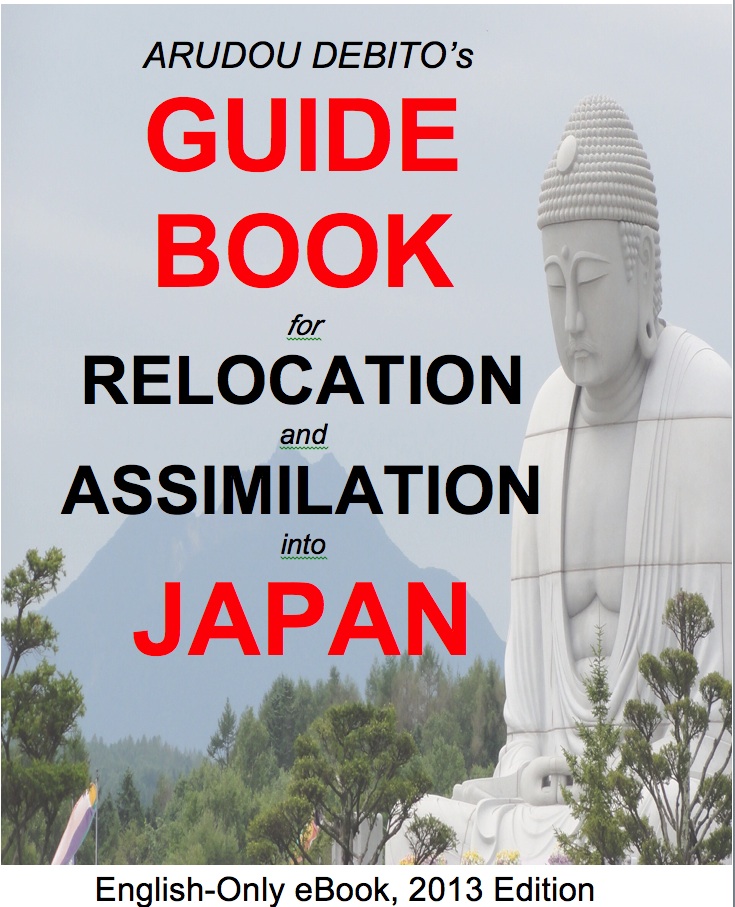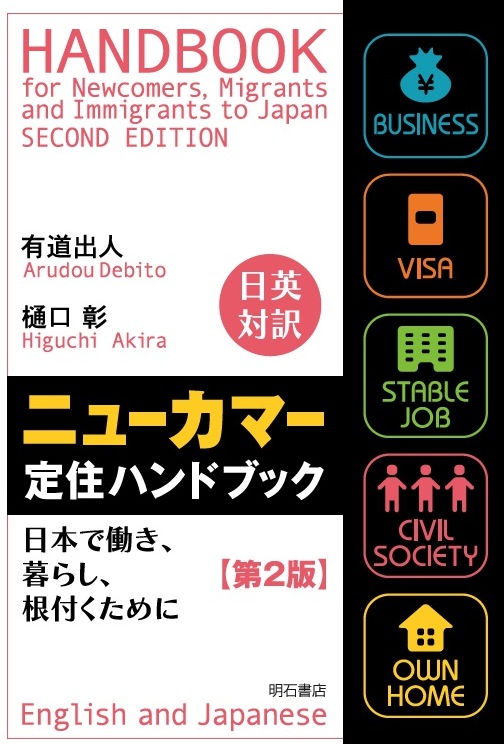mytest
Books, eBooks, and more from Dr. Debito Arudou (click on icon):





![]()


UPDATES ON TWITTER: arudoudebito
DEBITO.ORG PODCASTS on iTunes, subscribe free
“LIKE” US on Facebook at http://www.facebook.com/debitoorg
https://www.facebook.com/embeddedrcsmJapan
http://www.facebook.com/handbookimmigrants
https://www.facebook.com/JapaneseOnlyTheBook
https://www.facebook.com/BookInAppropriate
If you like what you read and discuss on Debito.org, please consider helping us stop hackers and defray maintenance costs with a little donation via my webhoster:

All donations go towards website costs only. Thanks for your support!
Hi Blog. We’ve talked about this in passing before, but let me highlight it as a separate blog entry: People in Japan are still accepting the antiquated notion of “race” as an abstract, biological concept. As opposed to a socially-constructed one that differs from society to society in its definitions and enforcement, or as a performative one that is created through the process of “differentiation”, “othering”, and subordination.
So strong is this centuries-old belief that even Mali-born naturalized Japanese Dr. Oussouby Sacko, recently-elected president of Kyoto Seika University (congratulations!), made the bold statement in the New York Times that his differential treatment in Japan is not due to racism:
“Dr. Sacko, a citizen of Japan for 16 years, says he is treated differently because he does not look Japanese. But he distinguished that from racism. ‘It’s not because you’re black,’ he said.”
Sorry, that’s not now modern definitions of racism work anymore, Dr. Sacko. Differential treatment of Visible Minorities in Japan is still a racialization process. But I guess anyone can succumb to the predominant “Japan is not racist” groupthink if it is that strong. Read the NYT article below for fuller context.
But the questions remain: Is this a form of Stockholm Syndrome? A cynical attempt to parrot the narrative for the sake of professional advancement? A lack of awareness and social-science training on the part of a person, despite fluency in several languages, with a doctorate in a non-social science (engineering/architecture)? I’m open to suggestion. Especially from Dr. Sacko himself, if he’s reading.
Anyway, much better articles than the NYT’s about Dr. Sacko’s background and training are available from Baye McNeil in the Japan Times here and here.
In any case, congratulations, Dr. Sacko. But I would suggest you utilize your position also to raise awareness about the very real issues of racism in Japan, not attempt a mitigating or denialist approach. Dr. Debito Arudou
////////////////////////////////
In Homogeneous Japan, an African-Born University President
New York Times, April 13, 2018, courtesy of DTJ
https://nytimes.com/2018/04/13/world/asia/japan-african-university-president-sacko.html
KYOTO, Japan — On a beautiful spring Sunday during cherry blossom season, the new president of Kyoto Seika University welcomed students for the start of the Japanese school year. “You have left your home,” he told the 770 first-year and graduate students gathered in a gym on the hilly campus. “But this is also your home.”
In Bamanankan — the lingua franca of his native Mali.
And so Oussouby Sacko, 51, quickly dispensed with the elephant in the room: He is a black man in a homogeneous country that has long had an ambivalent relationship with outsiders.
Dr. Sacko, who is believed to be the first African-born president of a Japanese university, segued elegantly into fluent Japanese, invoking Hannah Arendt, Edward Said, Eleanor Roosevelt and the Malian writer Amadou Hampâté Bâ. The university, Dr. Sacko said, was “diversifying and internationalizing,” and he wanted the students to “recognize your difference from others.”
In this island country that is sometimes less than welcoming to immigrants, Mr. Sacko is an outlier. A resident for 27 years, he obtained Japanese citizenship 16 years ago and worked his way up through the ranks of a Japanese institution.
With a declining population, Japan is being forced to confront its traditional resistance to taking in foreigners. Last year, according to government figures, the number of foreign nationals living in Japan hit a record high of more than 2.5 million, with about 15,140 of them from African countries.
Yet that total number of foreign nationals makes up less than 2 percent of Japan’s population of 127 million, a lower proportion than in South Korea, for example, where foreigners make up about 3.4 percent of the population. The share is much higher in the United States, at 14 percent, and it is close to 40 percent in Hong Kong, according to data from the United Nations Department of Economic and Social Affairs.
Obtaining Japanese citizenship is extremely difficult. Since 1952, just over 550,000 people have managed to naturalize as Japanese citizens, most of them ethnic Koreans whose families have lived in Japan for several generations since the colonial occupation of Korea.
And despite recent efforts to allow highly skilled foreigners to obtain permanent residency more quickly, Prime Minister Shinzo Abe has declared that he will not relax immigration policy to address the country’s falling population.
Dr. Sacko says he believes Japan needs to allow in more outsiders, simply as an act of self-preservation.
“Japanese people think they have to protect something,” he said during an interview in English before a reception recently to celebrate his appointment. But, “someone who has a broad view from outside on your culture can maybe help you objectively improve your goals,” he said, occasionally interrupting the interview to greet his guests, switching effortlessly between English, French and Japanese.
Dr. Sacko, the eldest son of a customs officer and homemaker, grew up in Bamako, the capital city of Mali. A strong student, he won a scholarship from the Malian government to attend college abroad.
He had never been anywhere other than the neighboring country of Senegal. With 13 other students from Mali, he was assigned to study in China and landed in Beijing in 1985 to study Mandarin before embarking on a degree in engineering and architecture at Southeast University in Nanjing.
On a vacation to Japan after obtaining his undergraduate degree in 1990, Dr. Sacko found himself enchanted by what he observed as strong community ties and the hospitality toward guests. Although he had begun graduate studies in China, he was frustrated that a government minder always shadowed him when he conducted field research in local villages.
He had also met and started to date a Japanese woman, Chikako Tanaka, whom he later married and with whom he has two sons.
Dr. Sacko moved to Osaka, Japan, for six months of language lessons before enrolling in a master’s degree program at Kyoto University. In meetings with colleagues, he was often asked to take minutes, which helped him improve his listening comprehension and writing ability. At night, he watched Japanese television shows and socialized with Japanese classmates.
Twenty percent of Kyoto Seika’s student body comes from abroad, much higher than the 4 percent overall ratio in Japanese higher education. Dr. Sacko hopes to raise Kyoto Seika’s figure to 40 percent within a decade.Kosuke Okahara for The New York Times
His dedication to becoming fluent distinguished him from other foreigners. “They said, ‘If you speak Japanese, they will put you in meetings and on committees and that’s not interesting,’ ” he said. Many foreigners, he added, “spend too much time among ourselves.”
Dr. Sacko said he had hoped to return to Mali someday, but after a military coup in 1991, his employment options were limited. As he pursued a doctorate in Japan, he worked to understand a culture where people can say the exact opposite of what they mean. “You don’t always catch things from the meanings of the words,” he said. “You have to go deeper.”
Along the way, there were some misunderstandings.
After hosting a few parties at his apartment, his neighbors remarked that he and his friends always seemed happy and that they were envious. Dr. Sacko urged them to join his next party.
Instead, they called the police.
“The police said, ‘You are too noisy,’ ” Dr. Sacko recalled. “And I said ‘But my neighbors like that!’ ”
He applied for a job at Kyoto Seika, which specializes in the arts, and started as a lecturer in 2001. Colleagues say that over the years he has worked very hard to adapt to Japanese social codes while also retaining his own sensibility.
“He deeply understands Japanese culture and the way of thinking,” said Emiko Yoshioka, a professor of art theory whom Dr. Sacko appointed as vice president at Kyoto Seika. “But he also is able to poke fun at the fact that he is a foreigner.”
The faculty vote for president was extremely close, with Dr. Sacko winning by just one vote. At his inaugural reception, a group of musicians played Malian music on a patio, and Dr. Sacko stood quietly on a small stage during a parade of speeches from the mayor of Kyoto; the Malian ambassador to Japan; and various academic colleagues, including a professor from Kyoto University who repeatedly slipped up and called him “Professor Mali.”
Ryo Ishida, chairman of Kyoto Seika’s board, noted that the university had recently started a campaign to embrace diversity.
“But I don’t think his election was much to do with the university’s promotion of diversity,” Mr. Ishida said. “He was elected as the best leader of the university among his colleagues.”
In a practical sense, Dr. Sacko’s appointment could help Kyoto Seika appeal to more foreign students at a time when many universities across Japan are struggling to maintain enrollment.
Already, 20 percent of its student body comes from abroad, much higher than the 4 percent overall ratio of foreign students in Japanese higher education. Dr. Sacko said he hoped to raise Kyoto Seika’s level to 40 percent within a decade.
“I think he will help shrink the distance between Japanese and foreigners,” said Chihiro Morita, 18, an illustration major from Hyogo Prefecture.
Other black residents of Japan said that Dr. Sacko could help improve race relations in a country where performers still appear on television in blackface.
“The fact that he has been placed in such a prominent position will have a significant impact on how we’re perceived,” said Baye McNeil, a Brooklyn-born black columnist for the English-language Japan Times who has lived in Japan for 13 years.
Dr. Sacko said he had not experienced racism in Japan but said he was treated differently simply because he does not look Japanese. Despite his Japanese citizenship, for example, he says he is automatically routed to lines for foreigners at the airport when he returns from trips abroad. “It’s not because you’re black,” he said. “It’s because you’re different.”
He said he considered it his mission to foster differences beyond race. When recruiting Ms. Yoshioka as vice president, he told her he wanted her for the job because she was a woman and a single mother.
“If we don’t have a person like you in the top administration of the university, the board will just be filled with men,” he told her when she first hesitated to take the job. “And that doesn’t fit my vision.”
ENDS
=============================
Do you like what you read on Debito.org? Want to help keep the archive active and support Debito.org’s activities? Please consider donating a little something. More details here. Or even click on an ad below.
14 comments on “NYT: Dr. Sacko, Kyoto Seika University’s African-Born President, claims no experience of racism in Japan. Just of “being treated differently because he doesn’t look Japanese”. Huh?”
To be honest, you’ve got to take NYT’s article with a grain of salt. Motoko Rich used to cover education in the US prior to her current position as a chief editor at NYT Tokyo Office. She’s not a bad reporter; many of her pieces are decent. But she doesn’t always cover the point we’re looking for.
Dr. Sacko has just got his crumbs from the big table! This is as far as he could ever have dreamed of going professionally in Japan, so it’s unrealistic to expect him to speak out and then fall into the ‘you hate one thing about Japan = you hate ALL things about Japan = go home gaijin!’ trap.
I suspect his ignorance of race issues is based on over-simplistic black/white structural contexts, which leaves him blind to what’s happening in Japan.
His mistake is not realizing that just because Japan discriminates against both black and white NJ does not equal equality.
Quite. His remark is an epitome of rhetorical dissociation that empowers him to claim his ‘renewed’ cultural identity and displaces racial identity simultaneously. It’s something a person of color may experience as the matter of her/his (over-)assimilation to host culture. A good example is a Native American man deciding to give up his indigenous cultural and family heritage (including language, custom, and even seeing skin color being peeled off and becoming almost the same as white) as the matter of assimilation/acculturation process.
What I see ironic in this case is an underlying assumption that acceptance to host culture would automatically erase any visible “differences” in one’s body regardless of race, ethnicity, or nationality. That’s just not true, and it’s really mind-boggling to see such fallacy skews public understanding of diversity in Japanese society.
I agree.
JIm, I think “discrimination” for him, means “having a bad life and losing job opportunites”, so he is not “discriminated” against negatively, just annoyingly i.e. micro aggressions but he can put up with them compared to a military coup in Mali, etc.
Its all relative.
Maybe. And yes, it is all relative.
I’m just kind of wondering if he’s fallen into the (Japanese) logical fallacy of thinking that racism is something that *only* white people do to people of other colors?
Who knows what this idiot really thinks? After all, he clearly doesn’t understand the definition of racial discrimination.
He has done well from humble beginnings, of course he isn’t going to rock the boat. He has too much of a vested interest.As well as this snippet “but after a military coup in 1991, his employment options were limited. ”
Some things in the article are typical of the NJ experience:
” a government minder always shadowed him when he conducted field research in local villages.”
-Was this in China? Sounds like an NJ handler in Shinagawa.
“He had also met and started to date a Japanese woman, Chikako Tanaka, whom he later married and with whom he has two sons.”
– A common reason why people stay in Japan. I personally cannot see any other advantage to being here unless you absolutely luck out with an expat deal.
” “But he also is able to poke fun at the fact that he is a foreigner.””
-House Gaijin clown, much? Wackily entertaining his colleagues? That’s odd, as my Japanese colleagues are ultra serious and rarely entertain me!
“professor from Kyoto University who repeatedly slipped up and called him “Professor Mali.””
Individuals defined by nationality/image? CHECK. How very postmodern, with a J nationalist twist!
And this last bit is just plain weird
“his mission to foster differences beyond race. ” So, he wants to highlight the differences? Good luck with that one.
Racism manifests itself in many different ways, some more benign than others, and that might be closer to what the Dr. is trying to explain. Maybe? However, identifying racism is quite easy. It is treating people differently based on their presumed race. And that is what he says is happening to him. The good doctor needs to think about how others can be affected by his blithe public dismissal of problematic attitudes in Japan.
Hopefully all readers will understand you are talking about Dr. Oussouby Sacko.
Yes, Dr. Oussouby Sacko’s blithe public dismissal of problematic attitudes in Japan (namely: Japanese culture continuing to treat all non-pure-Japanese-DNA humans differently based on race, labeling them “gaijin”, “halfs”, “quarters”, and denying equal treatment to all such “foreign race people” in Japan) is an action which negatively affects non-Japanese-DNA humans living in Japan.
Basically the problem with Dr. Oussouby Sacko is:
He said, “Being treated differently because one does not look ‘racially Japanese’ IS NOT racism. The definition of racism is limited to: being treated differently because one is BLACK.”
He should say, “Being treated differently because one does not look ‘racially Japanese’ IS racism. Racism is being treated differently because of one’s RACE or RACIAL APPEARANCE, and this harmful act is still commonly shamelessly being done daily by the majority in present-day Japan. Every time people raised in Japanese culture treat apparent ‘gaikoku-jins’ ‘gai-jins’ ‘halfs’ ‘quarters’ ‘foreign races’ differently than they treat ‘racially pure Japanese’, that is absolutely literally the definition of racism. I, Dr. Oussouby Sacko, hereby apologize for having denied that fact with my limited denial of racism in Japan. The false claim I made in the New York Times (namely, the ‘racism is only racism when whites treat blacks differently: when Japanese treat non-Japanese differently it is not racism’ false claim) was extremely damaging to centuries of Japan residents of all races who have endured and who are still enduring lifetime struggles towards the vitally important goal of Japanese culture one day treating all races equally. To atone for my mistake, I will endeavor from now on to help raise awareness about equal treatment for all races in Japan. I hereby boldly honestly state, even at the risk of angering any racist subordinates who might try to have me unjustly fired for saying this: the uncomfortable reality is Japanese culture must stop racially labeling people as ‘gaikoku-jins’ ‘gai-jins’ ‘halfs’ ‘quarters’ ‘foreign races’, Japan must stop treating such people differently than Japanese culture treats apparent ‘racially pure Japanese’ people, and Japanese culture must start treating all individuals equally without regard to race or racial appearance.”
He only scraped in by one vote, and “the university had recently started a campaign to embrace diversity.”
How much power does the president really have?Just a figurehead? With a win that narrow, one could argue he has about as much mandate as The Donald, and just as divisive.
I’d like to know if his university is sacking foreign English teachers due to the five year law.
But what’s the betting that if they are, the he would say it’s not racist since they are sacking NJ teachers irrespective of whether they are black or white?
“Obtaining Japanese citizenship is extremely difficult. Since 1952, just over 550,000 people have managed to naturalize as Japanese citizens”
No it’s not.
Many people don’t get Japanese citizenship because they don’t want to give up their birth citizenship.
Besides obtaining the right to vote there’s really no difference from being a citizen and a permanent resident but it makes a lot of financial and practical sense in keeping your original citizenship.
If the Japanese government would finally allow dual citizenship watch for the sudden increase of foreigners being naturalized.